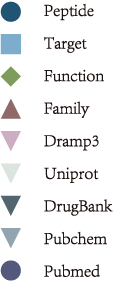(S)-Hexahydropyrrolo[1,2-A]Pyrazine-1,4-Dione
Basic information
| CPKB ID | CP00083 |
| IUPAC Name | (8aS)-2,3,6,7,8,8a-hexahydropyrrolo[1,2-a]pyrazine-1,4-dione |
| Synonyms |
|
| Source |
Rattus norvegicus [Division : Rodents]
Taxonomy :10116 (Metazoa-Chordata-Rodentia-Mammalia-Muridae Rattus) Wikipedia: Rattus norvegicus Coffea arabica [Division : Plants and Fungi]
Taxonomy :13443 (Viridiplantae-Streptophyta-Gentianales-Magnoliopsida-Rubiaceae Coffea) Wikipedia: Coffea arabica PubChem |
| Function | |
| Information |
(S)-Hexahydropyrrolo[1,2-a]pyrazine-1,4-dione is a natural product found in Rattus norvegicus, Coffea arabica, and other organisms with data available. |
Legend

Structure
download
| Molecular Formula |
C7H10N2O2 |
| Molecular Weight | 154.0742276 g/mol |
| SMILES | O=C1NCC(=O)N2CCC[C@@H]12 |
| InChI | InChI=1S/C7H10N2O2/c10-6-4-8-7(11)5-2-1-3-9(5)6/h5H,1-4H2,(H,8,11)/t5-/m0/s1 |
| InChIKey | OWOHLURDBZHNGG-ZEYBBFMUNA-N |
|
2D Structure
PubChem|126154
|
|
|---|---|
|
3D Structure
PubChem|126154
|
|
|
3D Structure (Complex)
PDB|1W1P
|
|
Sequence
| One letter code from Structure | PG |
| Amino acid chain from Structure | Gly--Pro |
| Description of the conversion sequence | The one letter code and Amino acid chain derived from the structural transformation may be inconsistent, with the Amino acid chain containing Essential Amino acid and the one letter code not. |
Biologic Determination
BioAssay Results
Show
entries
Search:
| Active | 5000.0 | Equal to | Chain A, Chitinase B (Serratia marcescens) | IC50 |
977608 | 46393438 |
Structure Properties
| Property Name | Property Value | |
|---|---|---|
| Exact Mass | 154.0742276 | |
| Number of Rings | 2.0 | |
| Complexity | 1.454545455 | |
| XlogP3 AA | -0.8928 | |
| Heavy Atom Count | 11.0 | |
| Hydrogen Bond Donor Count | 1.0 | |
| Hydrogen Bond Acceptor Count | 2.0 | |
| Rotatable Bond Count | 0.0 |
| Property Name | Property Value | |
|---|---|---|
| Formal Charge | 0.0 | |
| Refractivity | 37.7447 | |
| Rule_of_Five | 1.0 | |
| Number of Atoms | 11.0 | |
| Topological Polar Surface Area | 49.41 | |
| Refractivity | 37.7447 | |
| Veber Rule | 1.0 | |
| Ghose Filter | 0.0 |
| Property Name | Property Value | |
|---|---|---|
| RDKit Fingerprint |
01000000000000000100100000011000010000000011010000100010000000000000100001101000100000000010010010000000000001001000000000110000000000000000111000001101000100100100001000000010000110000110100100000000001001001000000000000000000100000100000110000000011100101011000100001000000010001001000000000000010010010000001000000001000100000000000011010000100000000010001000000000000010000000000000000010000100000000000100001100000010000000100000000001100011000000000100000010011000000000000000000010000010010100100000100100110000000000000010010101000000000000100010000100001000000100010010000000000000010000001000100001000010011000000000001001000000100010000010100110000000000110000000000000000100000100011100000000000001000000000100100011001000010000000000000000001100001000001100010000000001000001001000001000001000001000000000000001110000000000010010000000000000000010000000000001000100000000111000000011000100000000111000000100011000011000000000010110000000000000010001010000011000010000001000000001010100000000000000000000001000000011000100000010100000000010000000000000001001100001000000001001110010000001000001010010000000000000000110001001010010000000001000001000100110100110100101000000000000001010000001000000000001010100000010100000011100010010000010000000100100000010001000000000000000100000000001001001010010000000000000100000100000000001100100000000010000110001010000000000000000000000000000000000000000001100000000000000100010000000000010001010001000001011000100000100010000100001000000011011011000000000100100000110000000100000000000010000000000100000000010100000000100100010001001000101000010010001000000000001000000000000100000000100000000000010010000000001000010000100000010000001000000000000011100000100100000000001010010000000100000100011001000000000000010010000100000000000100000010010000000000001111001000100000000000000011010100110010000000000100000000000100000100000010000001001101100000100101100000000010000010001000010000110000010000000010001001000000000000001001001100000000001000000100000000000000001001010000100000000000000000011 |
|
| Morgan Fingerprint |
0000100000100000000000000000000000000000000000000000000000000000000000000000000000000000001000000000000000000000000000000000000000000000000000000000000000000000000000000000000000000000000000000000000000000000000000000000000000000001000000100000000000000000000000000000000000000000000000001000000000000100000000000010000000000000000000000000100000000000000010000000000000000000000000000000000000000000000000000000000000001000000000000000000000000010000000001000000000000000000000000000000000000000000000000000000000000000000000000000000000000000000000000000000000000000000000000000000000000000000000000000000000000000000000000000000000100000000000000010000000000000000000000000000000001000000001000000000000000000000000000000000000000000000000000000000000000000000000000000100000000000000000000000001000000000000000000000000000000000000000000010000000000000000000000000000000000000000000000000000100000000000000000000000000000010000000010000000000000000001000000000000000000000000000000000000000000000000000000000000000010000 |
|
| MACCS Keys |
00000000000000000000000000000000000000000000000000000000000000000000000000000001001101000011100110101100010000110000011011100001110010001110001100011001011010110101110 |
Sequence Properties
| Property Name | Property Value | |
|---|---|---|
| Boman Index | -0.47 | |
| Charge | -0.00201570060725275 |
Binding Target
Detail
Uniprot: P11797
Kind: Protein>Chitinase
Organism: Serratia marcescens
Evidevce: DrugBank
Sequence: MSTRKAVIGYYFIPTNQINNYTETDTSVVPFPVSNITPAKAKQLTHINFSFLDINSNLECAWDPATNDAKARDVVNRLTALKAHNPSLRIMFSIGGWYYSNDLGVSHANYVNAVKTPAARTKFAQSCVRIMKDYGFDGVDIDWEYPQAAEVDGFIAALQEIRTLLNQQTIADGRQALPYQLTIAGAGGAFFLSRYYSKLAQIVAPLDYINLMTYDLAGPWEKITNHQAALFGDAAGPTFYNALREANLGWSWEELTRAFPSPFSLTVDAAVQQHLMMEGVPSAKIVMGVPFYGRAFKGVSGGNGGQYSSHSTPGEDPYPNADYWLVGCDECVRDKDPRIASYRQLEQMLQGNYGYQRLWNDKTKTPYLYHAQNGLFVTYDDAESFKYKAKYIKQQQLGGVMFWHLGQDNRNGDLLAALDRYFNAADYDDSQLDMGTGLRYTGVGPGNLPIMTAPAYVPGTTYAQGALVSYQGYVWQTKWGYITSAPGSDSAWLKVGRLA
General Function:
Chitinase activity
Additional database information: TTD[Chitinase B]
Manufacturers
| Manufacturers Name | Value | |
|---|---|---|
| CreativePeptides | ||
| Bayer healthcare pharmaceuticals | ||
| Upsher smith laboratories | ||
| Merck |
| Manufacturers Name | Value | |
|---|---|---|
| Apotex | ||
| Baxter Healthcare Corp | ||
| Pharmasources | ||
| Novartis | ||
| AstraZeneca |
Forecasting tools
| Forecasting tools | Value | |
|---|---|---|
| Structure to Sequence | ||
| Structure Properties | ||
| Sequence to Structure | ||
| Sequence Properties | ||
| Expasy ProtParam Tool | PG | |
| SEA | RUN SEA Predictions |
Information Source
| Property Name | Property ID | |
|---|---|---|
| Patents | OWOHLURDBZHNGG-ZEYBBFMUNA-N | |
| pubchem | 126154 | |
| Drugbank | DB04541 | |
| DRAMP3 | ||
| Uniprot | ||
| Cybase | ||
| CONOSERVER | ||
| BindingDB | ||
| CHEMBL | CHEMBL360216 | |
| CTD | ||
| Wikipedia | Cyclic glycine-proline | |
| KEGG Compound/Drug | ||
| CHEBI | OWOHLURDBZHNGG-ZEYBBFMUNA-N | |
| EPA DSSTox | DTXSID60914215 | |
| FDA Global Substance Registration System (GSRS) | W7O69J5F2B | |
| DTP/NCI | ||
| Chemspider | 112149 |
Reference
| Pubmed_ID | Title | DOI | Journal | |
|---|---|---|---|---|
6143808 |
10.1111/j.2042-7158.1984.tb03018.x. | J Pharm Pharmacol |
||
Potentiation of cyclo (N-methyl-Tyr-Arg)-induced antinociceptive activity by thyrotropin-releasing hormone in miceAbstract
|
||||
6424102 |
10.1016/0196-9781(83)90081-5. | Peptides |
||
Actions of intracerebroventricular administration of kyotorphin and an analog on thermoregulation in the mouseAbstract
|
||||
6688782 |
10.1016/0014-2999(83)90024-9. | Eur J Pharmacol |
||
Antinociceptive effect of centrally administered cyclo(N-methyl-L-Tyr-L-Arg) in the ratAbstract
|
||||
6717754 |
10.1016/0028-3908(84)90209-0. | Neuropharmacology |
||
Comparison of the antinociceptive effects of intracerebroventricular injection of kyotorphin, cyclo (N-methyl-Tyr-Arg) and Met-enkephalin in miceAbstract
|
||||
